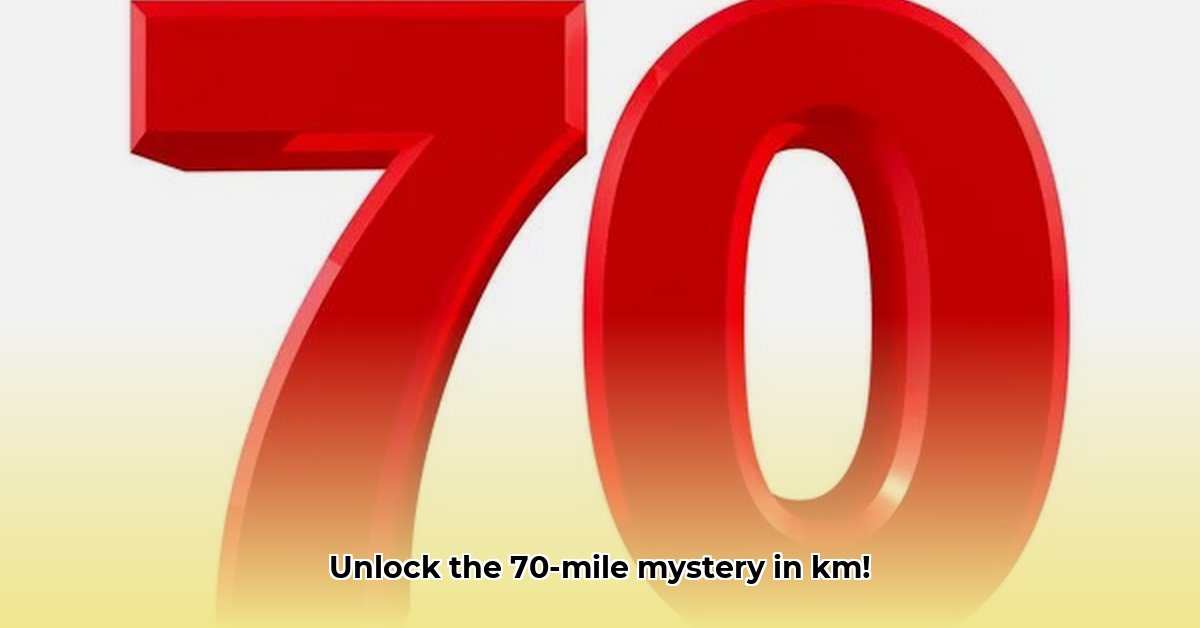Have you ever needed to convert miles to kilometers? Whether you’re planning a trip, working on a project, or just curious, understanding how to convert between these units is essential. This comprehensive guide provides everything you need to know, from simple formulas to practical applications. For a quick conversion of kilometers to miles, check out this helpful resource: 300 km to miles.
Understanding the Basics: Miles and Kilometers
Before diving into the conversion, let’s define our terms. A mile is a unit of length commonly used in the United States and the United Kingdom, equal to 5,280 feet or 1,760 yards. A kilometer, on the other hand, is a unit of length in the metric system, equal to 1,000 meters. Most of the world uses kilometers for measuring distances.
The Conversion Factor: Miles to Kilometers
The key to converting miles to kilometers is the conversion factor:
1 mile = 1.609344 kilometers
This constant allows us to easily switch between the two units.
Converting 70 Miles to Kilometers: Step-by-Step
Now, let’s convert 70 miles to kilometers using the conversion factor.
Step 1: The Formula
To convert miles to kilometers, multiply the number of miles by the conversion factor:
Kilometers = Miles × 1.609344
Step 2: The Calculation
For 70 miles:
Kilometers = 70 × 1.609344
Kilometers = 112.65408
Step 3: Rounding
Depending on the level of precision needed, you can round the result. For most practical purposes, rounding to one or two decimal places is sufficient. In this case, 112.65 kilometers.
Alternative Conversion Tools
While the formula is straightforward, several tools can simplify the process:
- Online Conversion Calculators: Numerous websites offer free mile-to-kilometer converters. Simply enter the number of miles, and the tool instantly provides the equivalent in kilometers.
- Smartphone Apps: Many unit converter apps are available for smartphones, allowing for quick conversions on the go.
- Spreadsheet Software: Programs like Microsoft Excel or Google Sheets can perform conversions using the formula in a cell.
The History of Miles and Kilometers
The mile and kilometer have distinct historical roots. The mile has origins in the Roman mile, which was 5,000 Roman feet. Over time, the definition of the mile varied until it was standardized. The kilometer, as part of the metric system, was developed during the French Revolution as a more rational and consistent unit of measurement. The metric system’s foundation is based upon fundamental physical constants, whereas the mile has evolved through more arbitrary definitions.
Why Different Systems Exist
The prevalence of different measurement systems often stems from historical and cultural factors. While most of the world has adopted the metric system, countries like the United States continue to use the imperial system for many applications.
Real-World Applications of Mile-to-Kilometer Conversions
Understanding how to convert miles to kilometers has numerous practical applications:
- International Travel: When traveling abroad, you’ll encounter distances displayed in kilometers. Knowing how to convert allows you to understand distances and plan your routes.
- Sports: Many sporting events involve distances measured in either miles or kilometers. Being able to convert between the two helps you understand race distances and performance metrics.
- Global Trade and Logistics: International shipping and logistics require accurate distance calculations for efficient delivery. Converting between miles and kilometers is essential for these operations.
- Aviation and Navigation: Precise measurements are critical for navigation, and the conversion factor is essential for flight planning.
Quick Conversion Chart
Here’s a handy table for quick reference:
| Miles | Kilometers |
|---|---|
| 1 | 1.609 |
| 5 | 8.047 |
| 10 | 16.093 |
| 20 | 32.187 |
| 50 | 80.467 |
| 70 | 112.654 |
| 100 | 160.934 |
Practical Applications for Road Trips
Converting miles to kilometers is incredibly useful when planning road trips, especially in countries that use the metric system, allowing for more accurate distance and time estimations:
Planning Your Route
Knowing the conversion allows you to accurately interpret road signs and maps, helping you plan your daily driving distances.
Fuel Efficiency
Understanding the distance you’ll be traveling in kilometers allows you to estimate your fuel consumption more accurately, ensuring you don’t run out of gas unexpectedly.
Speed Limits
Speed limits are often posted in kilometers per hour (km/h) in many countries. Being able to quickly convert to miles per hour (mph) helps you stay within the legal limits.
Using GPS and Navigation Systems
Many GPS devices and navigation apps allow you to switch between miles and kilometers, making it easy to understand distances and estimated arrival times.
Conclusion: The Importance of Unit Conversions
Converting miles to kilometers is more than just a mathematical exercise; it’s a practical skill that enhances our understanding of the world. As global interactions increase, understanding different measurement systems becomes more crucial than ever before. The ability to convert between units fosters better communication and reduces potential errors across various sectors, which helps in simplifying international travel and more.
- Grace Hopper: The Admiral Who Made Computers Speak English: A Legacy of Innovation - August 4, 2025
- Lincoln’s Telegraph: Winning the Civil War - August 4, 2025
- Rosalind Franklin: The Uncredited Pioneer Behind DNA’s Structure: A Deeper Look - August 4, 2025
















